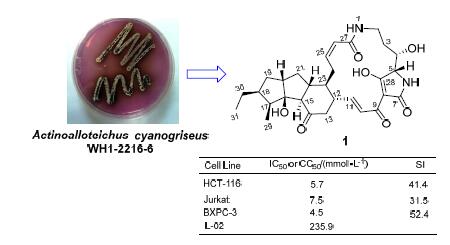| [1] Zhao, C.; Zhu, T.; Zhu, W. Chin. J. Org. Chem. 2013, 33, 1195(in Chinese). (赵成英, 朱统汉, 朱伟明, 有机化学, 2013, 33, 1195.)
[2] Blodgett, J. A.; Oh, D. C.; Cao, S.; Currie, C. R.; Kolter, R.; Clardy, J. Proc. Natl. Acad. Sci. U. S. A. 2010, 107, 11692.
[3] Zhang, G.; Zhang, W.; Saha, S.; Zhang, C. Curr. Top Med. Chem. 2016, 16, 1727.
[4] Jomon, K.; Kuroda, Y.; Ajisaka, M.; Sakai, H. J. Antibiot. 1972, 25, 271.
[5] Gunasekera, S. P.; Gunasekera, M.; McCarthy, P. J. Org. Chem. 1991, 56, 4830.
[6] Kanaxawa, S.; Fusetani, N.; Matsunaga, S. Tetrahedron Lett. 1993, 34, 1065.
[7] Jakobi, M.; Winkelmann, G.; Kaiser, D.; Kempter, C.; Jung, G.; Berg, G.; Bahl, H. J. Antibiot. 1996, 49, 1101.
[8] Graupner, P. R.; Hornburgh, S. T.; Mathiesonc, J. T.; Chapin, E. L.; Kemmitt, G. M.; Brown, J. M.; Snipes, C. E. J. Antibiot. 1997, 50, 1014.
[9] Yu, F.; Zaleta-Rivera, K.; Zhu, X.; Huffman, J.; Millet, J. C.; Harris, S. D.; Yuen, G.; Li, X. C.; Du, L. Antimicrob. Agents Chemother. 2007, 51, 64.
[10] Nakayama, T.; Homma, Y.; Hashidoko, Y.; Mizutani, J.; Tahara, S. Appl. Environ. Microbiol. 1999, 65, 4334.
[11] Li, Y.; Huffman, J.; Li, Y.; Du, L.; Shen, Y. Med. Chem. Commun. 2012, 3, 982.
[12] Xu, L.; Wu, P.; Wright, S. J.; Du, L.; Wei, X. Y. J. Nat. Prod. 2015, 78, 1841.
[13] Saha, S.; Zhang, W.; Zhang, G.; Zhu, Y. G.; Chen, Y. C.; Liu, W.;Yuan, C. S.; Zhang, Q. B.; Zhang, H. B.; Zhang, L. P.; Zhnag, W. M.; Zhang, C. S. Chem. Sci. 2017, 8, 1607.
[14] Li, S.; Du, L.; Yuen, G.; Harris, S. D. Mol. Biol. Cell 2006, 17, 1218.
[15] Li, S.; Calvo, A. M.; Yuen, G. Y.; Du, L.; Harris, S. D. J. Eukaryot. Microbiol. 2009, 56, 182.
[16] Li, S.; Jochum, C. C.; Yu, F.; Zaleta-Rivera, K.; Du, L.; Harris, S. D.; Yuen, G. Y. Phytopathology 2008, 98, 695.
[17] Qian, G.; Hu, B.; Jiang, Y.; Liu, F. Agric. Sci. China 2009, 8, 68.
[18] Lou, L.; Chen, H.; Cerny, R. L.; Li, Y.; Shen, Y.; Du, L. Biochemistry 2012, 51, 4.
[19] Lou, L.; Qian, G.; Xie, Y.; Hang, J.; Chen, H.; Zaleta-Rivera, K.; Li, Y.; Shen, Y.; Dussault, P. H.; Liu, F.; Du, L. J. Am. Chem. Soc. 2011, 133, 643.
[20] Fu, P.; Wang, S.; Hong, K.; Li, X.; Liu, P.; Wang, Y.; Zhu, W. J. Nat. Prod. 2011, 74, 1751.
[21] Jia, H.-J.; Wang, C.; Wang, Y.; Liu, P.-P.; Zhu, W.-M. Chin. J. Mar. Drug. 2014, 33, 9(in Chinese). (贾海健, 王聪, 王乂, 刘培培, 朱伟明, 中国海洋药物, 2014, 33, 9.)
[22] Lacret, R.; Oves-Costales, D.; Gómez, C.; Díaz, C.; de la Cruz M; Pérez-Victoria, I.; Vicente, F.; Genilloud, O.; Reyes, F. Mar. Drugs 2014, 13, 128. |
